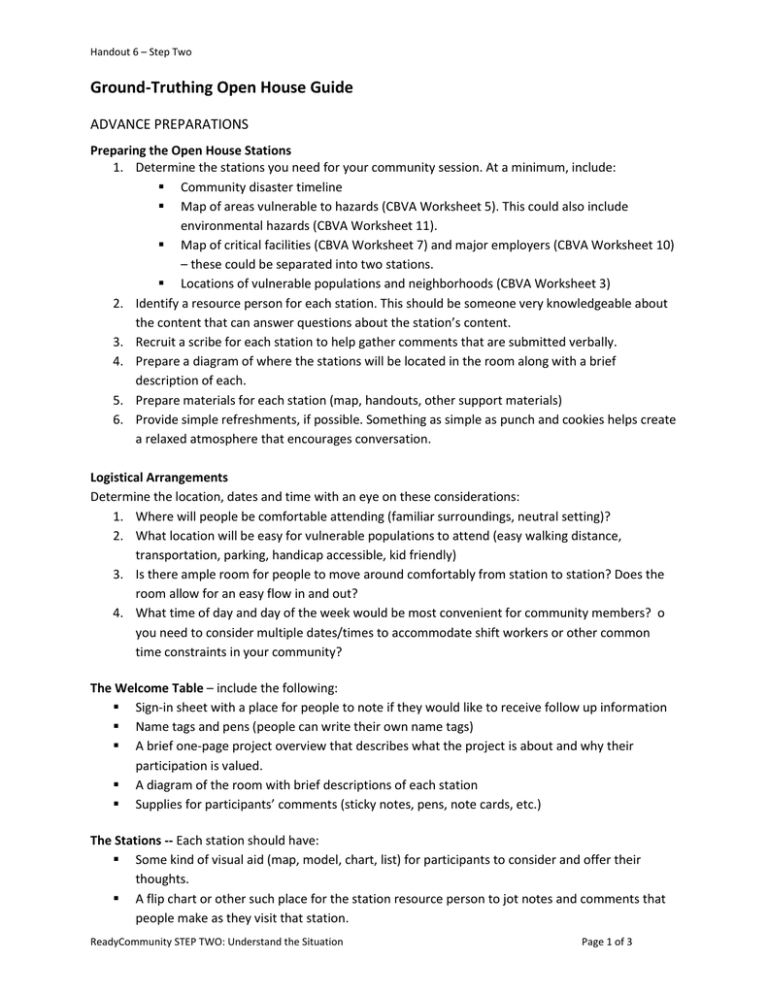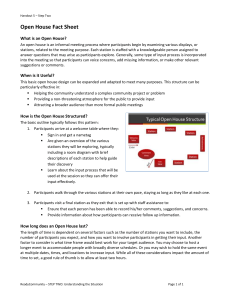Handout 6 - Ground-Truthing Open House Guide
advertisement

Handout 6 – Step Two Ground-Truthing Open House Guide ADVANCE PREPARATIONS Preparing the Open House Stations 1. Determine the stations you need for your community session. At a minimum, include: Community disaster timeline Map of areas vulnerable to hazards (CBVA Worksheet 5). This could also include environmental hazards (CBVA Worksheet 11). Map of critical facilities (CBVA Worksheet 7) and major employers (CBVA Worksheet 10) – these could be separated into two stations. Locations of vulnerable populations and neighborhoods (CBVA Worksheet 3) 2. Identify a resource person for each station. This should be someone very knowledgeable about the content that can answer questions about the station’s content. 3. Recruit a scribe for each station to help gather comments that are submitted verbally. 4. Prepare a diagram of where the stations will be located in the room along with a brief description of each. 5. Prepare materials for each station (map, handouts, other support materials) 6. Provide simple refreshments, if possible. Something as simple as punch and cookies helps create a relaxed atmosphere that encourages conversation. Logistical Arrangements Determine the location, dates and time with an eye on these considerations: 1. Where will people be comfortable attending (familiar surroundings, neutral setting)? 2. What location will be easy for vulnerable populations to attend (easy walking distance, transportation, parking, handicap accessible, kid friendly) 3. Is there ample room for people to move around comfortably from station to station? Does the room allow for an easy flow in and out? 4. What time of day and day of the week would be most convenient for community members? o you need to consider multiple dates/times to accommodate shift workers or other common time constraints in your community? The Welcome Table – include the following: Sign-in sheet with a place for people to note if they would like to receive follow up information Name tags and pens (people can write their own name tags) A brief one-page project overview that describes what the project is about and why their participation is valued. A diagram of the room with brief descriptions of each station Supplies for participants’ comments (sticky notes, pens, note cards, etc.) The Stations -- Each station should have: Some kind of visual aid (map, model, chart, list) for participants to consider and offer their thoughts. A flip chart or other such place for the station resource person to jot notes and comments that people make as they visit that station. ReadyCommunity STEP TWO: Understand the Situation Page 1 of 3 Handout 6 – Step Two A handout, if appropriate, that people can view as they talk. At least one question to help guide the responses. It may be helpful to post the question on an easel or wall beside the station so that people can add their comments. Some suggested questions include: o At the Community Disaster Timeline: What hazards concern you the most in this community? This could be set up as a poll on a chart to which people add sticky dots to vote. Start by listing the most likely hazards but allow participants to add to the list if their biggest concern is not included. Based on your experiences in this community, what hazards have we missed and how can we learn more about them? o At the map of areas vulnerable to hazards: Are you aware of other areas that are particularly vulnerable to hazards that we have not identified? If so, where are they and what makes them more vulnerable? (i.e. a low lying road that floods quickly, an unpaved road that is impassable when icy or wet, etc.) o Map of critical facilities and major employers: Are there other facilities in the area that you believe are critical in the face of a disaster? If so, where and why? Are there other facilities in the area that could be used during a disaster that currently are not? If so, how could they be used? Are there other places where large numbers of people gather regularly? o Locations of vulnerable populations (post a definition of “vulnerable populations” and a list of who might be included). Are you aware of other areas where vulnerable populations live? Are there other people who might be at greater risk of harm in an emergency if we don’t make plans to assist them? What do you see as the most important things we need to be ready to do to help people who are least able to help themselves in an emergency? o Exit comment station: What is the one thing you think could help the community be better prepared for a disaster? The Comment and Exit Station – Have a place for participants to: Turn in any comments not already submitted Sign up to participate in further sessions Sign up to receive a summary report from this session Learn more about how they can prepare for disasters. This would be a good place to have handouts about personal/family disaster preparation, community resources, etc. Be sure a project representative is at this station to personally thank participants and encourage their participation in the other events. ReadyCommunity STEP TWO: Understand the Situation Page 2 of 3 Handout 6 – Step Two MANAGING THE GROUND-TRUTHING OPEN HOUSE Welcoming Participants As people arrive: Welcome them, ask them to sign in and create a name tag. Give them a pen and a packet of post-it notes (or whatever you choose for your commenting/feedback process). Give them a diagram of the room and explain the various stations and invite them to visit each one to consider the information displayed. Encourage them to use the post-it notes to make suggestions and comments at each station. Explain that there is no need to write their name on these unless they choose to. Encouraged to visit each station and to feel free to start at any station and work their way around the room. Engaging the Participants Coach each of the station staff on how to encourage participants to come close to view and respond to the questions. Since this experience may be new to many participants, they may need to be encouraged to engage rather than quickly “window shop” each station and keep walking. (See strategies under “floaters” for some ideas.) Have “floaters” who can talk to people that are not engaged in discussions at the stations. As the floaters identify people that seem to just be standing around or walking past stations without stopping to talk and/or write down comments/suggestions try these strategies: Talk to the participants about something of interest at one of the stations they haven’t visited. Walk with them to the station and ask their thoughts about something at the station. Get them talking about one of the questions posted at one of the stations. Then ask them if they would mind sharing those thoughts at that station. Keep in mind that some people may be reluctant to write their own comments for various reasons. Be sensitive to that possibility. If someone seems hesitant, ask if they would mind you recording their insights. Thanking Participants Having one or more people staffed at the door as participants exit is very important. This last point of contact before people leave should be used to: Genuinely thank people for coming Answer any last questions they may have Get one overarching insight from them (such as the one suggested above at the exit comment station: What is the one thing you think could help the community be better prepared for a disaster?). Encourage them to participate in the future civic engagement sessions. Gather contact information for anyone that would like to hear more about the project. ReadyCommunity STEP TWO: Understand the Situation Page 3 of 3


